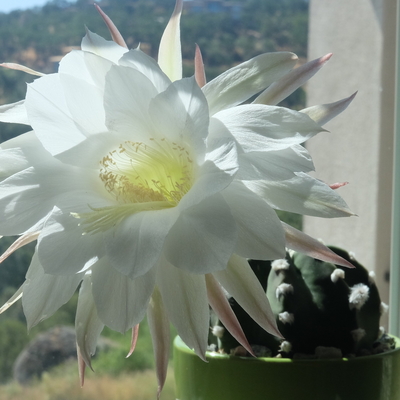 Savings. Shopping.
Savings. Shopping.Domino Cactus - Echinopsis subdenudata 'fuzzy navel'

25 promo codes
Get ready to meet the Domino Cactus - also known as Echinopsis subdenudata 'Fuzzy Navel,' a vibrant variety of the Echinopsis genus! This particular variety of Echinopsis subdenudata is commonly referred to as 'fuzzy navel' due to the soft and velvety appearance of its spines. It is also sometimes mistakenly referred to as the easter lily cactus or the hedgehog cactus. This little domino cactus is a true showstopper, with its soft, fuzzy white tufts that resemble adorable polka dots (like dominos - hence its name) on its dark green body. Hailing all the way from Bolivia, this fuzzy navel cactus may pack a punch when it comes to its mesmerizing night-blooming cactus. Its stunning white domino cactus flowers with long tube blooms from early spring to late summer, like elegant flags fluttering in the wind. This small winter-dormant cactus grows as a solitary stem and reaches up to 6 inches in height. This lively fuzzy navel cactus will start producing offsets and growing together in a cluster formation, creating an entire family of beautiful plants. Propagation by seeds is a slow process, but you can propagate it through offsets by the mother plant. This can be done in any season. Echinopsis subdenudata is a friendly cactus. It is suitable for beginner gardeners. The Domino Cactus truly knows how to make an entrance and keep things exciting in any garden or indoor space. Watering Needs Like most other cacti, the domino cactus is adapted to survive in arid environments with limited water availability. As such, it doesn't require frequent watering. Overwatering can actually be detrimental to the health of this fuzzy navel plant, as it can lead to root rot and other issues. It's best to allow the soil to dry out completely before watering the plant again. If the soil is still damp, wait a few more days before watering. When watering the Domino cactus, it's important to use a well-draining soil mix and a container with several drainage holes to prevent water from pooling around the roots. Water this fuzzy cactus slowly and deeply once in 2-3 weeks in the growing season. It's always a good idea to keep a paper towel on hand to blot up any excess water after watering. In general, it's better to go underwater than overwater cacti, so err on the side of caution if you're unsure about when to water your Domino cactus. Light Requirements The Domino cactus prefers full sun to partial shade. It can tolerate some direct sunlight, but too much can cause sunburn and other issues. If you're growing your fuzzy cactus indoors, place it near a south or east-facing window to ensure it gets enough light. If you notice that your cactus is leaning towards the light, rotate it every few weeks to ensure that all sides of the plant receive adequate light. In general, cacti are very adaptable to bright light and can tolerate a range of lighting conditions. However, insufficient light can cause the Domino cactus to become weak and leggy, while too much light can cause it to become discolored or burnt. If you're unsure about the lighting conditions in your home, try using a light meter to determine how much light your domino cactus is receiving. Optimal Soil & Fertilizer Needs This hedgehog cactus prefers a well-draining potting soil mix that is specifically formulated for cacti. You can find these soil mixes at most garden centers or online. Avoid using the garden's own soil mix or other heavy soils, as these can retain too much moisture and lead to root rot and other issues. Ideally, you want to use our specialized cactus potting mix that contains 5 natural substrates and organic mycorrhizae to promote the development of a strong root system that helps your cactus to thrive. The domino Cacti don't require too much fertilizer, but you can give this hairy cactus a boost by using a balanced fertilizer once a year during the growing season (spring). Be sure to use an equal natural organic mix of NPK with a 5-10-5 ratio. Don't fertilize your cactus during the dormant season (fall and winter months), as this can cause damage to the Echinopsis cactus. Keep in mind that cacti are slow-growing plants, so be patient and avoid overwatering or over-fertilizing in an attempt to speed up growth. Hardiness Zones & More The Domino cactus is not frost-hardy and is best when grown outdoors, in USDA hardiness zones 9-11. The cactus prefers warm temperatures and can tolerate a range of humidity levels, but it's best to avoid placing it in an area with high humidity, as this can lead to rot and other issues. In terms of temperature, the hedgehog cactus prefers a sunny climate with daytime temperatures between 70-90°F and nighttime temperatures between 60-70°F. If the temperature drops below 50°F, the fuzzy plant may become dormant and stop growing. If you live in a colder climate, you can still grow the fuzzy navel cactus indoors or in a greenhouse. Be sure to keep it away from air conditioning vents or other sources of cold air. Give this Echinopsis subdenudata 'fuzzy navel a try if you're looking for an easy plant to care for!
Save on Domino Cactus - Echinopsis subdenudata 'fuzzy navel' with a Planet Desert promo code
Checkmate is a savings app with over one million users that have saved $$$ on brands like Planet Desert.
The Checkmate extension automatically applies Planet Desert discount codes, Planet Desert coupons and more to give you discounts on products like Domino Cactus - Echinopsis subdenudata 'fuzzy navel'.


























































